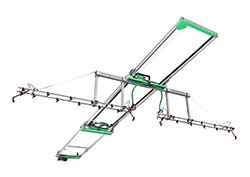Greenhouse Irrigation: Providing Essential Moisture
Efficient irrigation is the lifeline of any greenhouse setup. Plants rely on water for essential functions like photosynthesis and nutrient absorption. However, in an enclosed space, water needs to be carefully managed to avoid overwatering, water wastage, or creating conditions that promote disease. A well-planned greenhouse irrigation system ensures even water distribution, which is key to maintaining healthy crops and optimizing growth.
Greenhouse irrigation systems come in different types, each with specific advantages depending on the plants’ needs. Drip irrigation, for example, is one of the most popular systems. It uses a network of tubes and emitters to deliver water directly to the base of each plant. This minimizes water loss through evaporation and directs moisture right to the roots, reducing the risk of fungal infections caused by excess humidity. Overhead sprinkler systems, another option, can be beneficial for certain crops but need to be carefully managed to avoid high humidity levels that could encourage mold or mildew.
Automated irrigation systems have become popular due to their precision and efficiency. These systems use sensors to monitor moisture levels in the soil and activate the irrigation only when necessary. Such systems help maintain ideal conditions for plant growth while conserving water, which is increasingly essential in regions prone to water shortages.
Greenhouse Screen System: Controlling Light and Temperature
Beyond irrigation, controlling light and temperature is essential for a successful greenhouse operation. A greenhouse screen system helps regulate these factors, making it easier to maintain an optimal environment for plant development. Screens are typically installed as retractable layers that can be adjusted to provide shade, retain heat, or even act as a barrier against pests.
Light intensity is a critical factor for photosynthesis, the process by which plants convert light into energy. During peak sunlight hours, too much light can damage delicate plants, causing issues like leaf burn and stunted growth. A greenhouse screen system allows growers to control the amount of sunlight entering the greenhouse, which can be crucial during hot summer months. Shading screens are often made from woven aluminum or high-density polyethylene, materials that reflect sunlight while still allowing some light penetration, thus reducing heat buildup without darkening the greenhouse too much.
Temperature management is another significant function of greenhouse screen systems. During cooler seasons, thermal screens can help retain heat within the greenhouse by acting as insulation barriers. These screens reduce the need for artificial heating, saving energy and lowering operational costs. On the other hand, retractable screens can be opened during the night or cooler parts of the day to allow ventilation and prevent overheating. Humidity can also be regulated by adjusting screens, which can reduce disease risks in high-humidity conditions.
Greenhouse screens also offer a layer of protection against pests. Certain screens are designed to block insects, keeping harmful pests out while allowing airflow. This reduces the need for chemical pesticides and supports organic growing practices.
Integrating Greenhouse Irrigation and Screen Systems
When greenhouse irrigation and screen systems are well-integrated, they form a powerful combination for environmental control. For example, by coordinating irrigation with screen adjustments, a grower can control both soil moisture and humidity levels effectively. Automated systems can even link both irrigation and screens to sensors, providing data-driven adjustments based on real-time greenhouse conditions.






Comments